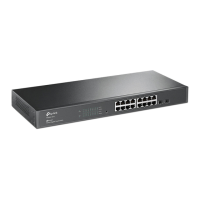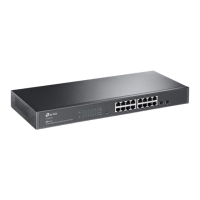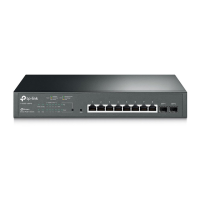JetStream Gigabit Stackable Smart Switch
Installation
08
Rack
Figure 2-3 Rack Installation
Caution:
■
Please set 5-10cm gaps around the device for air circulation.
■
Please avoid any heavy thing placed on the device.
■
Please mount devices in sequence from the bottom to top of the rack and ensure a
certain clearance between devices for the purpose of heat dissipation.
2.5 Stacking Using SFP+ Port
You can connect up to 6 switches to form a stack with a single management IP
address. Follow the steps below to connect the switches and configure the stack ports,
then the switches will automatically elect a master unit and establish a stack. Once the
stack is established, you can use any port of any switch in the stack to manage the
stack system.
Any SFP+ ports (Port 25-28) on the front panel can be used for stacking. Port 25-26
belong to Stack Port Group 0 and Port 27-28 belong to Stack Port Group 1. Since stack
capability cannot be enabled in the two groups simultaneously, you can enable stack
feature in either Group 0 or Group 1.
Here is an example of a recommended configuration that uses three rack-mounted
switches to form a full-ring stack.
Conguration and Connection
1. Log on to the GUI of each switch, go to Stack
→
Stack Management
→
Stack
Config page to enable the Stack Capability of port 25 and 26 (port 1/0/25 and
1/0/26 on the GUI). Remember to click Apply after the configuration.
2. Power off the switches, and then use the 10G SFP+ cable (TXC432-CU1M/TXC432-
CU3M of TP-LINK for example) to connect each switch to the next in a cascade.
Finally, connect the last switch in the stack to the first switch, thus forming a ring
topology as Figure 2-4 shows. The ring topology system provides redundancy and
resiliency to the stack.

